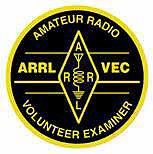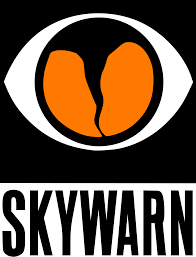Why NVIS?
We as amateur radio operators are typically focusing our efforts on HF towards long distance communication, "DXing". You would think the same would be true for emergency communications as well; however, in many instances what is needed is solid communications within the area of the emergency and the areas immediately surrounding it. During an incident we will often need to communicate to different parts of the state and, perhaps, adjacent states to exchange information to the "outside world" until normal communications resumes.
So, that fantastic all-band fan dipole antenna you have 80 feet in the air, while great for talking to China from West Georgia, will quite possibly make it very difficult, if not impossible, to reliably communicate with Macon. Why? because HF DX communication relies on atmospheric skip, and your fantastic antenna is liable to be throwing your signal at an angle up towards the horizon, right over the heads of the people around you, only to bounce off the atmosphere and land in Asia or Europe or California. What is ordinarily a fantastic thing is actually proving to be a hindrance for emergency communications.
The solution to the problem is to not lob those radio signals over the heads of the people within a few hundred miles of you, and the way to do that is NVIS (Near Vertical Incident Skywave), often pronounced "nevis". NVIS is really just a fancy way of saying we're going to aim our radio signals more vertical so they don't go flying over the horizon, but rather, go almost straight up to be reflected back down. Properly implemented, NVIS allows for good reliable communications in an area about 300 miles in diameter from your station. To visualize the concept, imagine taking a water hose and pointing it straight up at the ceiling - the water will hit the ceiling and then splatter in all directions around you. That's what we do with NVIS, aim the signal at the atmosphere above and let all those radio waves splatter back down.
How does NVIS work?
The rule of thumb for HF is that you'll get better DX the higher your antenna. The reason for this is that as a typical dipole antenna is raised higher, the take-off angle of MOST of the radio signals become shallower, closer to the horizon. This shallower angle provides for greater skip of the radio signal off the atmosphere, just like skipping a rock on water. Remember, however, that not all the signal is on one narrow angle, just the largest single component. It's like a Bell Curve, where angles above and below the take-off angle will have decreasing levels of signal.
What many don't think about is the converse, that as the antenna moves closer to the ground the take-off angle becomes steeper, until at some point it is almost straight up. This is a result of Ground being close enough to interact with the dipole and act as a sort of director as in a Yagi antenna.
Conventional wisdom is that once an antenna's height is below 1/4th wavelength the antenna becomes NVIS. It is really more appropriate to say that at 1/4 wavelength the antenna becomes more NVIS than conventional, but will more likely exhibit tendencies of both. The reason is that the take-off angel is a gradual thing as opposed to flipping a switch, so as the antenna is raised the take-off angle decreases and as it is lowered take-off angle increases. Since ideal performance for DX communications is 1/2 wavelength most of us are probably operating somewhere between DX and NVIS, as an 80 meter antenna would ideally need to be 140ft in the air to eliminate the NVIS component!
Note that I mentioned 80 meters being hybrid NVIS DX for most of us, and probably mostly NVIS. As the wavelength decreases and, at the same time, frequency increases, the typical antenna installation becomes more DX and less NVIS. To minimize the NVIS component you would need an antenna at 70ft for 40 meters, 35 feet for 20 meters, and 18 feet for 10 meters. Most of us are probably operating with a significant NVIS component until we get to 20 meters or shorter wavelengths.
Now, some of you are saying you're DXing on 80 meters with antennas 20 or 30 feet in the air, and I have no doubt you are telling the truth. As I said earlier, the take-off angle isn't a razor's edge, it has a width to it, meaning you'll have NVIS and DX components even with an antenna lower than ideal.
Maximizing NVIS
So, we've concluded that we want our antennas somewhere below 1/4 wave to have a more significant NVIS component to our signals, but how low should we go? Many proponents say as low as 10 feet off the ground! Many have tested antennas at 30ft and 15ft, getting reports of 15db stronger signal from stations inside a 300 mile radius and a 4 "S" unit decrease in noise using the lower antenna! Many serious NVIS experimenters agree on the 10-15ft height for 40-80 meters.
Some have experimented with creating a "Ground Yagi", but running a grounded wire below the dipole to act as a reflector, seeing as much as 6db additional gain.
Keep in mind that NVIS works on the principle that your transmitted radio signals will reflect off the atmosphere. As you may recall, there is a Maximum Usable Frequency (MUF), above which will not bounce off the atmosphere but will go straight through into space. As a result, NVIS is normally only possible at wavelengths of 40 meters or longer, with shorter wavelengths having frequencies above the MUF.




